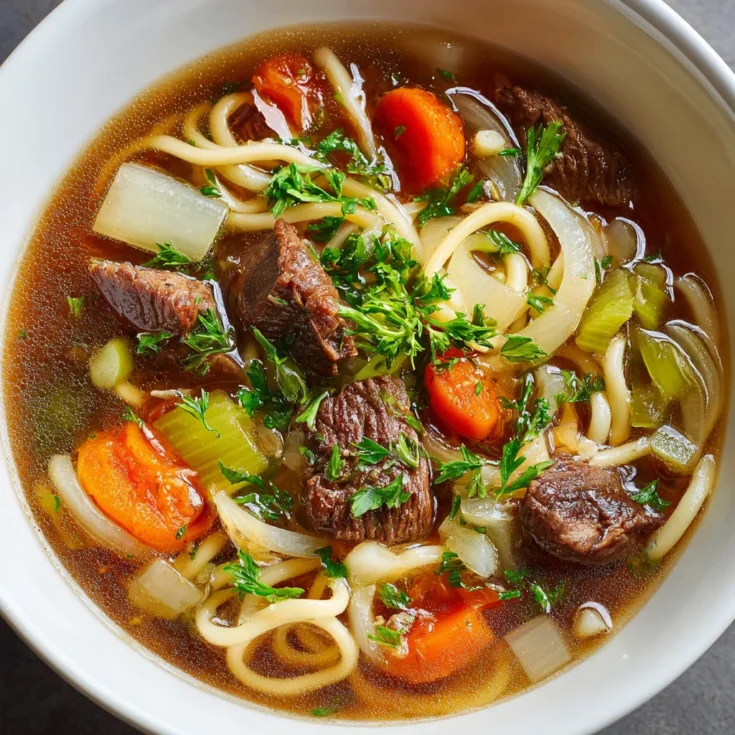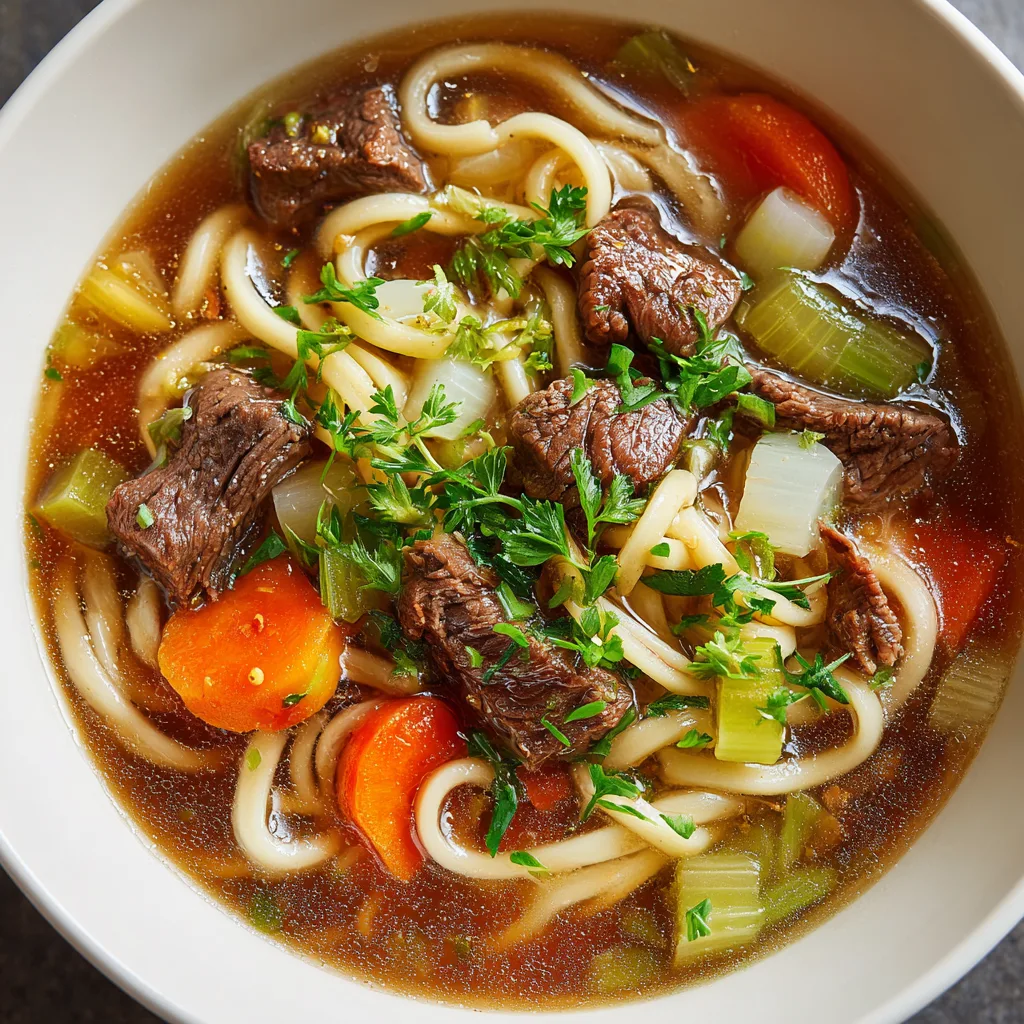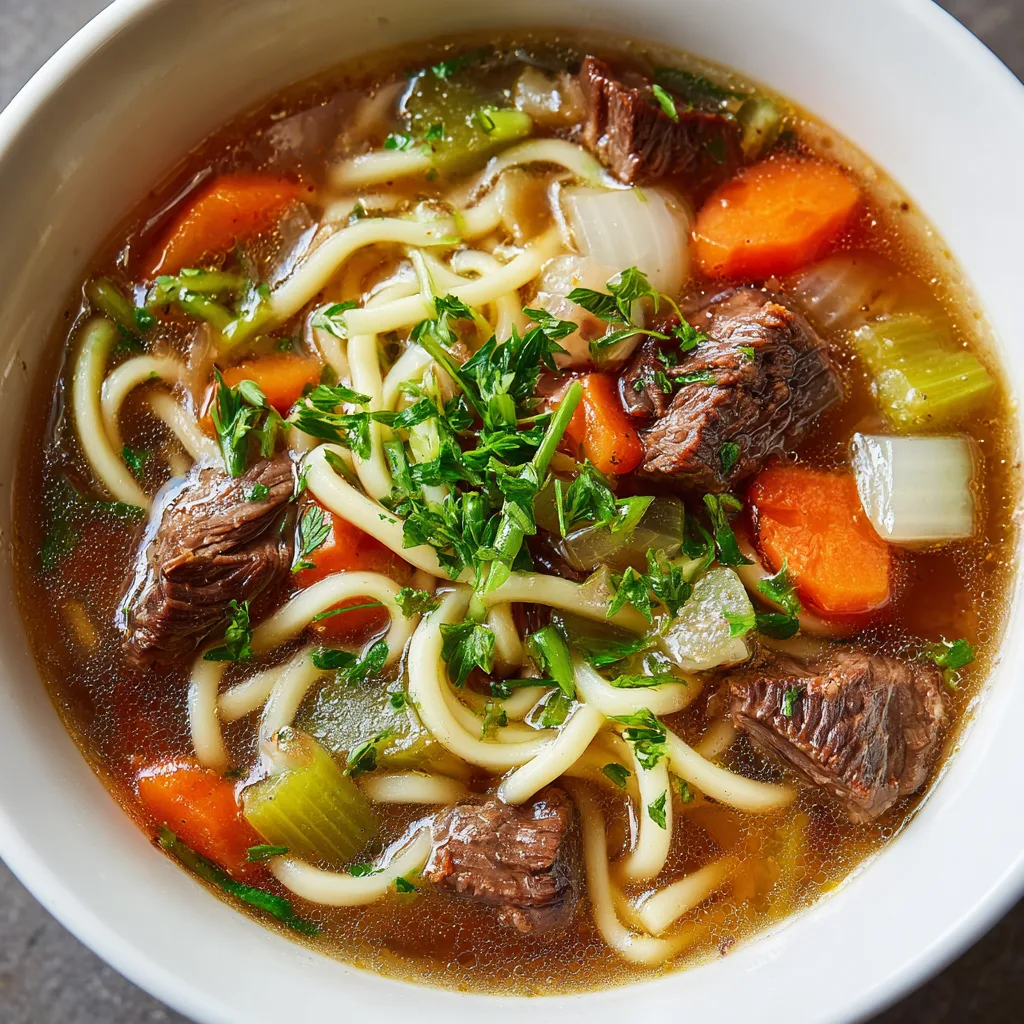Beef noodle soup has long been a beloved comfort food across many cultures. Its rich, savory broth paired with tender beef and noodles creates a dish that warms both the body and soul. This classic meal offers satisfaction on chilly days and nourishment whenever hunger strikes. Yet, traditional recipes often include heavy fats, excess sodium, or refined noodles that may not align with today’s health-conscious choices.
Making beef noodle soup healthy does not mean sacrificing flavor. By selecting lean cuts of beef, using wholesome noodles, and adding fresh vegetables, you can create a vibrant and nutritious meal. This approach preserves the soup’s comforting essence while boosting its nutritional profile. The result is a delicious dish that supports your well-being without feeling like a compromise.
In this article, you will discover the key benefits of healthy beef noodle soup, including the nutrients it provides and why it fits well into a balanced diet. We will explore the best ingredients to use, from protein-rich beef to nourishing vegetables and noodles that suit various dietary needs. Additionally, you’ll find practical preparation tips, cooking techniques, and tasty variations to keep this meal fresh and exciting. Finally, a helpful FAQ section will address common questions to guide you in making your own healthy beef noodle soup with confidence.
Why Choose Healthy Beef Noodle Soup?
Beef stands out as a powerful source of protein, essential for muscle repair and growth. It also supplies important minerals like iron and zinc, which support immune function and energy levels. Lean beef options offer these benefits without unnecessary saturated fats, making them ideal for a healthy soup.
Wholesome noodles, such as whole grain or rice varieties, contribute valuable fiber and essential nutrients. These alternatives to refined noodles promote better digestion and steady energy release. You can also explore low-carb or vegetable-based noodles to match specific dietary preferences.
A balanced broth made from quality ingredients serves as the soup’s foundation. When combined with fresh vegetables like carrots, spinach, and bok choy, the broth delivers hydration, vitamins, and antioxidants. This combination not only enhances flavor but also strengthens the soup’s overall health benefits.
Selecting the Best Beef Cuts for Soup
Choosing the right beef cut is essential for a healthy beef noodle soup. Lean cuts like sirloin, eye of round, and flank steak provide rich flavor with minimal fat. These cuts tenderize well when simmered, offering a satisfying texture without excessive grease. To further reduce fat content, trim visible fat from the meat before cooking. This simple step lowers saturated fat and keeps the soup light.
Grass-fed beef differs nutritionally from conventional beef. It often contains more omega-3 fatty acids and antioxidants, promoting heart health and reducing inflammation. Additionally, grass-fed beef tends to have a better fat profile. While slightly more expensive, it adds a wholesome dimension to your soup. If unavailable, lean conventional beef still works well when properly trimmed and cooked.
Choosing the Right Noodles for Healthy Beef Soup
The type of noodles you use greatly impacts the soup’s nutritional value. Whole wheat noodles offer more fiber and nutrients than traditional refined wheat pasta. They help maintain steady blood sugar levels and promote digestive health. Rice noodles provide a gluten-free alternative, ideal for those with sensitivities. Their mild flavor blends smoothly with rich broth and beef.
For low-carb or vegetable-focused diets, consider zucchini noodles or shirataki noodles. Zucchini noodles add vitamins and minerals while reducing calories and carbohydrates. Shirataki noodles, made from konjac yam, have almost no calories and a unique texture that works well in soup. Choosing the right noodle depends on your dietary needs and flavor preferences.
Vegetables and Broth Essentials for Nutritious Soup
Vegetables transform beef noodle soup from hearty to healthful. Carrots, spinach, bok choy, and mushrooms bring vitamins, minerals, and antioxidants. Carrots add sweetness and vitamin A, supporting vision and immunity. Spinach and bok choy contribute iron, calcium, and fiber. Mushrooms offer unique antioxidants and umami flavor that deepens the broth’s taste.
Broth quality matters significantly. Homemade broth lets you control sodium levels and avoid additives common in store-bought versions. Simmering beef bones with vegetables releases collagen and nutrients, enriching the soup’s texture and health benefits. If using store-bought broth, select low-sodium or organic options to reduce excess salt and chemicals.
To make a nutrient-rich, low-sodium broth at home, use plenty of fresh vegetables and herbs. Avoid adding salt early; season gradually toward the end. This method preserves natural flavors and ensures a balanced taste without overwhelming saltiness. A wholesome broth paired with fresh vegetables completes the foundation for a nourishing, healthy beef noodle soup.
Macronutrients Breakdown of Healthy Beef Noodle Soup
Healthy beef noodle soup delivers a balanced mix of macronutrients essential for energy and overall wellness. The lean beef supplies a rich source of high-quality protein. Protein supports muscle repair, growth, and satiety, keeping you full longer. The amount of protein varies depending on the cut and portion size but typically ranges between 20 to 30 grams per serving.
Carbohydrates come mainly from the noodles and vegetables. Whole wheat or rice noodles provide complex carbohydrates that fuel the body steadily. Vegetables like carrots and bok choy add natural sugars and fiber, which aid digestion and regulate blood sugar levels. The fiber content promotes gut health and contributes to a feeling of fullness.
Healthy fats in this soup are minimal, especially when using trimmed lean beef. This helps limit saturated fat intake, which benefits heart health. Some recipes may include small amounts of healthy fats from cooking oils such as olive or avocado oil, enhancing flavor without excess calories. Avoiding heavy cream or fatty cuts keeps the soup light and nutritious.
Micronutrients and Antioxidants in Beef Noodle Soup
Beyond macronutrients, beef noodle soup offers a wealth of vitamins and minerals. Beef is rich in iron, zinc, vitamin B12, and selenium—nutrients vital for energy metabolism, immune function, and cognitive health. Iron from beef also improves oxygen transport in the blood, reducing fatigue.
Vegetables add a diverse array of micronutrients. Carrots provide beta-carotene (vitamin A), supporting vision and skin health. Leafy greens contribute calcium, magnesium, and vitamin K, essential for bone strength and blood clotting. Mushrooms supply antioxidants like selenium and ergothioneine, which help neutralize harmful free radicals.
Antioxidants in this soup play a key role in boosting the immune system and reducing inflammation. The broth hydrates the body while aiding digestion by soothing the stomach and facilitating nutrient absorption. Warm soups like this promote hydration, especially when rich in water-based vegetables and broth.
Suitability for Special Diets: Gluten-Free, Low-Carb, and Paleo Options
Healthy beef noodle soup adapts well to various dietary needs. For gluten-free diets, swap traditional wheat noodles with rice noodles or vegetable-based alternatives like zucchini noodles. These options eliminate gluten while maintaining satisfying texture.
Low-carb and keto variations replace noodles with shirataki or spiralized vegetables to reduce carbohydrate intake. Such swaps keep the dish flavorful without disrupting ketosis or blood sugar control.
For paleo followers, use homemade bone broth and whole, unprocessed ingredients. Avoid processed soy sauce, opting instead for coconut aminos or natural seasonings. These adjustments ensure the soup aligns with paleo principles while remaining hearty and delicious.
Step-by-Step Preparation Guide for Healthy Beef Noodle Soup
Start by selecting lean beef cuts such as sirloin or flank steak. Slice the beef thinly to ensure quick, even cooking. Heat a tablespoon of olive oil in a large pot over medium-high heat. Add the beef slices and brown them until they develop a rich color on all sides. Browning locks in flavor and creates a delicious base for the soup. Remove the beef from the pot and set aside.
Next, focus on the broth. You can either use a high-quality store-bought low-sodium beef broth or make your own. To make broth, simmer beef bones with aromatics like onion, garlic, and herbs for several hours. Homemade broth offers deeper flavor and more nutrients. Pour the broth into the pot and bring it to a gentle boil.
Once the broth is ready, add your chosen vegetables. Carrots, mushrooms, bok choy, and spinach work well. These vegetables add color, texture, and vitamins. Simmer the vegetables in the broth until they soften but remain vibrant, usually about 10 to 15 minutes.
Finally, cook the noodles separately to avoid overcooking. Boil noodles according to package instructions, drain, and rinse under cold water to stop the cooking process. Add the noodles to the soup just before serving to keep them firm and prevent sogginess. Return the browned beef to the pot and heat through briefly. Your healthy beef noodle soup is now ready to enjoy.
Cooking Tips for Maximum Flavor and Health
Enhance your soup’s flavor naturally by using fresh herbs and spices. Garlic and ginger add warmth and depth, while black pepper offers a gentle kick. Star anise and cinnamon can introduce subtle sweetness and complexity, especially in Asian-inspired recipes. These aromatics elevate the taste without adding calories or unhealthy elements.
Avoid excessive salt and processed flavor enhancers. Instead, balance the soup’s taste with natural ingredients like a splash of low-sodium soy sauce or a squeeze of fresh lime juice. Taste as you go to prevent over-seasoning. Fresh herbs such as cilantro or green onions make excellent garnishes, brightening the dish and boosting nutrition.
Steer clear of cream, butter, or fatty cuts that add unnecessary saturated fat. Use healthy oils in moderation and keep the broth light. This approach ensures your soup stays both flavorful and heart-friendly.
Time-Saving Tips for Busy Cooks
Pressure cookers and slow cookers are invaluable tools for preparing beef noodle soup efficiently. A pressure cooker can reduce broth simmering time from hours to under an hour without sacrificing flavor. Slow cookers allow you to set ingredients early and come home to a ready meal, making dinner preparation stress-free.
Prepare ingredients ahead by chopping vegetables and slicing beef in advance. Store these components in airtight containers in the fridge. This prep work cuts down on cooking time during busy weekdays.
If you want to enjoy this soup multiple times, consider freezing portions. Cool the soup completely, then package it in freezer-safe containers. When ready, thaw overnight in the fridge and gently reheat on the stove. This strategy provides convenient, healthy meals with minimal effort, perfect for a busy lifestyle.
Popular Variations of Beef Noodle Soup
Beef noodle soup comes in many delicious variations worldwide. Asian-style versions, like Vietnamese pho and Taiwanese beef noodle soup, highlight bold spices and fragrant herbs. Pho uses a clear, aromatic broth with star anise and cinnamon, garnished with fresh basil and lime. Taiwanese beef noodle soup often features a rich, savory broth with soy sauce and tender chunks of beef, creating a heartier experience.
For low-carb diets, swap traditional noodles with vegetable alternatives such as zucchini or shirataki noodles. These options reduce carbohydrates without sacrificing texture. You can also add extra protein by including tofu, boiled eggs, or additional lean meat. Increasing vegetable variety, like adding bell peppers, snap peas, or kale, boosts fiber and nutrients, making the soup even healthier.
Serving Suggestions and Pairings
Enhance your soup’s flavor and presentation with fresh garnishes. Chopped cilantro, sliced green onions, and a squeeze of lime brighten each bowl. For those who enjoy heat, chili flakes or fresh sliced chili peppers add a spicy kick. These simple additions elevate the eating experience and add vibrant color.
Pair beef noodle soup with light sides such as steamed dumplings, a crisp cucumber salad, or simple spring rolls. These complement the warm, hearty soup without overpowering it. When it comes to leftovers, store the soup in airtight containers in the refrigerator for up to three days. Keep noodles separate if possible to prevent sogginess.
To reheat, warm the broth and vegetables gently on the stove, then add fresh noodles just before serving. This preserves texture and freshness. Proper storage and reheating ensure your healthy beef noodle soup stays delicious and nutritious for multiple meals.
Frequently Asked Questions About Healthy Beef Noodle Soup
What is the healthiest beef cut for soup?
Lean cuts like sirloin, flank steak, and eye of round provide rich flavor with less fat, making them ideal.
Can I make beef noodle soup gluten-free?
Yes, by using rice noodles or other gluten-free alternatives and tamari instead of soy sauce.
How can I reduce the sodium content in beef noodle soup?
Use low-sodium broth, avoid adding extra salt early, and choose fresh herbs for seasoning.
What are good alternatives to traditional noodles?
Zucchini noodles, shirataki noodles, or spiralized vegetables work well for low-carb or gluten-free options.
How long does beef noodle soup last in the fridge?
Stored properly, it lasts up to three days in an airtight container.
Healthy Beef Noodle Soup – Nutritious & Comforting Meal

A hearty, nutritious beef noodle soup packed with lean beef, fresh vegetables, and wholesome noodles, perfect for a healthy meal anytime.
Ingredients
- 1 lb lean beef cuts (e.g., sirloin), thinly sliced
- 6 cups low-sodium beef broth
- 2 cups whole wheat or rice noodles
- 1 cup sliced carrots
- 1 cup baby spinach or bok choy
- 2 cloves garlic, minced
- 1 tbsp fresh ginger, grated
- 1 tbsp soy sauce or tamari (gluten-free option)
- Salt and pepper to taste
- Optional herbs and spices (star anise, green onions, chili flakes)
Instructions
Notes




